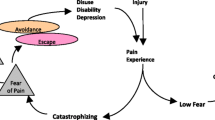Abstract
Objective: Based on the fear-avoidance and helplessness models, the relative contribution of fear of pain, avoidance behavior, worrying, and helplessness were examined in relation to fluctuations in functional disability in chronic-pain patients. Methods: A cohort of 181 chronic-pain patients first completed various questionnaires and kept a 7-day pain journal during a standard 3-month waiting-list period prior to their scheduled treatment at an Interdisciplinary Pain Centre and did so again immediately preceding the intervention. Results: At baseline, fear of pain, avoidance behavior, and helplessness all predicted functional disability after 3 months. Stepwise regression analyses showed avoidance behavior to be the strongest predictor of change in functional disability followed by helplessness, thus both ahead of fear of pain. Conclusion: The current findings support the roles of both fear-avoidance factors and helplessness in the functional disability in chronic-pain patients awaiting treatment but revealed a central role for avoidance behavior.
Similar content being viewed by others
References
Abramson, L., Seligman, M., & Teasdale, J. (1978). Learned helplessness in humans: Critique and reformulation.Journal of Abnormal Psychology, 87(1), 49–74.
Asmundson, G., Norton, P., & Norton, G. (1999). Beyond pain: The role of fear and avoidance in chronicity.Clinical Psychology Review, 19(1), 97–119.
Blyth, F., March, L., Brnabic, A., Joms, L., Williamson, M., & Cousins, M. (2001). Chronic pain in Australia: A prevalence study.Pain, 89, 127–134.
Burns, J., Glenn, B., Bruehl, S. Harden, R., & Lofland, K. (2003). Cognitive factors influence outcome following multidisci- plinary chronic pain treatment: A replication and extension of a cross-lagged panel analysis.Behaviour Research and Therapy, 41, 1163–1182.
den Boer, J. den, Oostendorp, R., Beems, T., Munneke, M., & Evers, A. (2006). Continued disability and pain after lumbar disc surgery: The role of cognitive-behavioral factors.Pain, 123, 45–52.
Evers, A., Kraaimaat, F., Lankveld, W., Jongen, P., & Bijlsma, J. (2001). Beyond unfavorable thinking: The Illness Cognition Questionnaire for chronic diseases.Journal of Consulting and Clinical Psychology, 69, 1026–1036.
Fritz, J., George, S., & Delitto, A. (2001). The role of fear-avoidance beliefs in acute low back pain: Relationships with current and future disability and work status.Pain, 94, 7–15.
Jensen, M., & McFarland, C. (1993). Increasing the reliability and validity of pain intensity measurement in chronic pain patients.Pain, 55, 195–203.
Jensen, M., Turner, J., & Romano, J. (2001). Changes in beliefs, catastrophizing, and coping are associated with improvement in multidisciplinary pain treatment.Journal of Consulting and Clinical Psychology, 69(4), 655–662.
Keefe, F., Scipio, C., Giordano, L., & Perri, L. (2004). Psychological aspects of persistent pain: Current state of the science.Journal of Pain 5(4), 195–211.
Kerlinger, F. (1975).Foundations ofbehavioral research. New York: Holt, Rinehart, Winston.
Kraaimaat, F., & Evers, A. (2003). Pain coping strategies in chronic pain patients: Psychometric characteristics of the Pain Coping Inventory (PCI).International Journal of Behavioral Medicine, 41(11), 1295–1310.
Lethem, J., Troup, J., & Bentley, G. (1983). Outline of a fear- avoidance model of exaggerated pain perception-1.Behaviour Research and Therapy, 21, 401–408.
Linton, S., Buer, N., Vlaeyen, J., & Hellsing, A. (2000). Are fear- avoidance beliefs related to the inception of an episode of back pain? A prospective study.Psychology and Health, 14, 1051–1059.
Pollard, A. (1984). Preliminary validity study of the Pain Disability Index.Perceptual and Motor Skills, 59, 974.
Roelofs, J., Goubert, L., Peters, M., Vlaeyen, J., & Crombez, G. (2004). The Tampa Scale of Kinesiophobia: Further examination of psychometric properties in patients with chronic low back pain and fibromyalgia.European Journal of Pain, 8,495- 502.
Samwel, H. J., Evers, A., Crul, B. J. P., & Kraaimaat, F. (2006). The role of helplessness, fear of pain, and passive pain-coping in chronic pain patients.Clinical Journal of Pain, 22(3), 245–251.
Schoenfeld-Smith, K., Petroski, G., Hewett, J., Johnson, J., Wright, G., Smarr, K., et al. (1996). A biopsychosocial model of disability in rheumatoid arthritis.Arthritis Care and Research, 9(5), 368–375.
Seligman, M. (1972). Learned helplessness.Annual Review of Medicine, 23,407–412.
Smith, C., & Wallston, K. (1992). Adaptation in patients with chronic rheumatoid arthritis: Application of a general model.Health Psychology, 11(3), 151–162.
Sullivan, M., Thorn, B., & Haythornwaite, J. (2001). Theoretical perspectives on the relation between catastrophizing and pain.The Clinical Journal of Pain, 17, 52–64.
Swinkels-Meewisse, I., Roelofs, J., Schouten, G., Verbeek, A., Oostendorp, R., & Vlaeyen, J. (2006). Fear of moment/ (re)injury predicting chronic disabling low back pain: A prospective inception cohort study.Spine, 31(6), 658–664.
van Tulder, M. van, Koes, B., & Bouter, L. (1995). A cost-of illness study of back pain in the Netherlands.Pain, 62, 233–240.
Vlaeyen, J., & Linton, S. (2000). Fear-avoidance and its consequences in chronic musculoskeletal pain: A state of the art.Pain, 85, 317–332.
Author information
Authors and Affiliations
Corresponding author
Rights and permissions
About this article
Cite this article
Samwel, H.J.A., Kraaimaat, F.W., Evers, A.W.M. et al. The role of fear-avoidance and helplessness in explaining functional disability in chronic pain: a prospective study. Int. J. Behav. Med. 14, 237–241 (2007). https://doi.org/10.1007/BF03002998
Issue Date:
DOI: https://doi.org/10.1007/BF03002998




